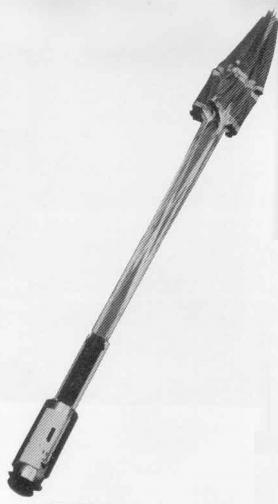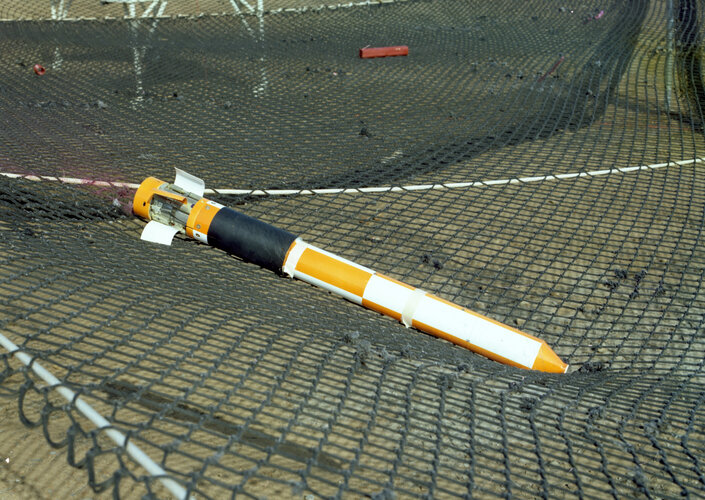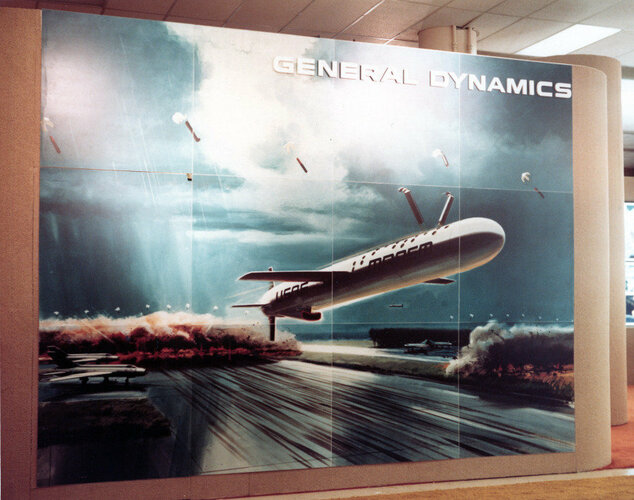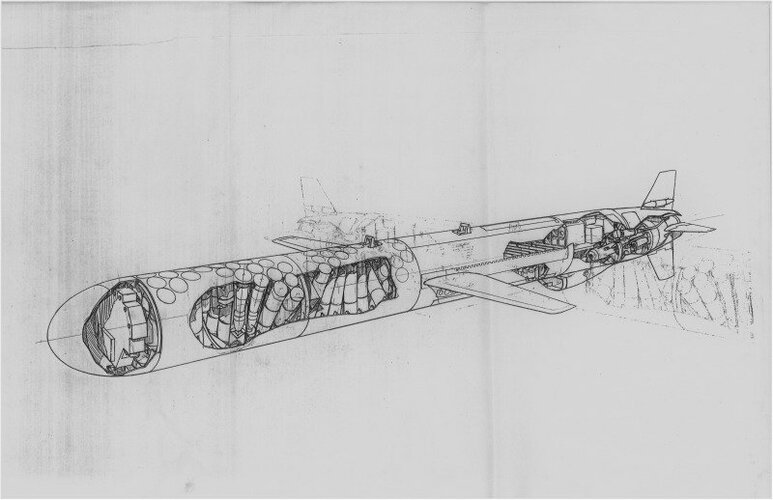You are using an out of date browser. It may not display this or other websites correctly.
You should upgrade or use an alternative browser.
You should upgrade or use an alternative browser.
AGM-109 dispenser
- Thread starter CIC-TAO
- Start date
- Joined
- 16 April 2008
- Messages
- 8,984
- Reaction score
- 12,611
Don't see this very often -- USAF MRASM (probably AGM-109H?). Obviously a runway attack version but the precise submunition used isn't obvious to me. There were quite a few candidates. The final winner was the Boosted Kinetic Energy Penetrator but this looks like something else. Maybe the German STABO?
- Joined
- 3 June 2011
- Messages
- 17,847
- Reaction score
- 10,846
Just a guess but I think that's just conceptual. The actual missile ejects it submunitions to the side.Does anyone know the exact model?
(0:34)
- Joined
- 3 June 2011
- Messages
- 17,847
- Reaction score
- 10,846
STABO is pretty big for a submunition. Probably too big in this orientation. (Significantly longer than the diameter of the missile.)Don't see this very often -- USAF MRASM (probably AGM-109H?). Obviously a runway attack version but the precise submunition used isn't obvious to me. There were quite a few candidates. The final winner was the Boosted Kinetic Energy Penetrator but this looks like something else. Maybe the German STABO?

DEU - STABO : Cluster Bombs and Submunition
Technical-tactical data
Weight: 17 kg
Dimensions:
- diameter of 132 mm
- length: 603 mm (without front cover 580 mm)
- Joined
- 16 April 2008
- Messages
- 8,984
- Reaction score
- 12,611
Oh, right. Thanks. Same issue rules out BKEP.
Possibly it was the Lawrence Livermore Tactical Airfield Attack Munition (TAAM), about which very little has been written. I only know it existed from the discussion of MRASM versions and possible payloads in this official cruise missile history (starting at page 205).
The relevant excerpt:
Possibly it was the Lawrence Livermore Tactical Airfield Attack Munition (TAAM), about which very little has been written. I only know it existed from the discussion of MRASM versions and possible payloads in this official cruise missile history (starting at page 205).
https://media.defense.gov/2017/Apr/07/2001728474/-1/-1/0/B_0006_WERRELL_EVOLUTION_CRUISE_MISSILE.PDF
The relevant excerpt:
The MRASM differed from the strategic cruise missile in three ways: requiring much less range, a terminal guidance system, and a different munition. The demands of range and accuracy appear to be well in hand. The technology to get a cruise missile hundreds of miles within hundreds of feet of a target, with TERCOM, and then within tens of feet of the target, with terminal guidance (DSMAC or SMAC), is both available and demonstrated. The developer's biggest problem centers on the munition, which according to the aviation press is the reason for the conservative schedule. The concept is to crater the runway and taxiway at 2,000-foot intervals. The MRASM can carry 50 to 80 submunitions totaling up to 1,000 pounds of payload.
Beginning in 1976, the United States and Great Britain jointly developed such a munition, the JP-233 runway buster. "Was" is the key word, because in early 1981 Congress decided the United States should withdraw from the program, primarily because of cost, much to the chagrin of the Air Force. The JP-233 contains cratering and delayed action mines as well as antipersonnel devices. The RAF used it in the 1982 Falkland Islands campaign. [NOTE: This is incorrect; JP.233 was not employed in the Falklands.]
Other runway-busting munitions under development included the Lawrence Livermore Laboratory's tactical airfield attack munition (TAAM). It is a 3.35-inch diameter, 13-pound, two-charge munition fitted into mortar tubes. The cruise missile discharges 60 to 80 of these devices, each retarded by a parachute before detonation. But the US military cancelled TAAM because of technical problems in July 1982. The Germans demonstrated the same type of weapon, the STABO, to American authorities at Eglin AFB in September 1982. The German STABO also uses a two-charge system, as does a similar munition - the boosted kinetic energy penetrator (BKEP) - under development by the Air Force Armament Division. After release from MRASM, a rocket charge in the BKEP drives a steel spike through the runway concrete where it explodes and creates a large crater. The Air Force MRASM can carry 28 BKEPs or 30 STABOs. Other munitions considered for this role include the 70-pound BLU-81 Grasshopper, the 16-pound Martin Dual Charge, and the 45-pound cluster airfield denial munition (CADM). But to knock out a 240-foot-wide runway may require multiple sorties (the kill probability of a 15-shot load of BLU-81s is .5, a 40-shot load of Martin Dual Charge is .6, and a 20-shot load of CADM is .3). The Air Force narrowed its attention to the STABO and BKEP, and conducted a direct competition in September 1982 to choose between the two. In February 1983, the JCMPO recommended purchase of the BKEP.
Last edited:
- Joined
- 3 June 2006
- Messages
- 2,938
- Reaction score
- 3,126
FYI, SDASM uploaded a few pictures showing early tests of the AGM-109 MRASM with Boosted Kinetic Energy Penetrator (BKEP) munition to their flickr archive.
Here an appetiser, where only the front section of the Tomahawk with the BKEP munition is tested.
View: https://flic.kr/p/2pWzQeY
Here an appetiser, where only the front section of the Tomahawk with the BKEP munition is tested.
View: https://flic.kr/p/2pWzQeY
- Joined
- 3 June 2011
- Messages
- 17,847
- Reaction score
- 10,846
Hah! Just stumbled onto this on the Flickr archive about an hour ago.FYI, SDASM uploaded a few pictures showing early tests of the AGM-109 MRASM with Boosted Kinetic Energy Penetrator (BKEP) munition to their flickr archive.
Here an appetiser, where only the front section of the Tomahawk with the BKEP munition is tested.
View: https://flic.kr/p/2pWzQeY

Tomahawk missile fan
ACCESS: Restricted
- Joined
- 19 September 2022
- Messages
- 37
- Reaction score
- 40
Very intresting Tomahawk Cruise Missile Video.
View: https://youtu.be/WyeMyhKE5Yw?si=tOvXimu6zrjZLPDS
Similar threads
-
-
UK Requirements: SR(A) 1236 CASOM
- Started by overscan (PaulMM)
- Replies: 12
-
Cancelled AGM-65 Maverick projects
- Started by AN/AWW-14(V)
- Replies: 18
-
-
1980s US intercontinental cruise missile (& ATCM program)
- Started by GeorgeA
- Replies: 37


